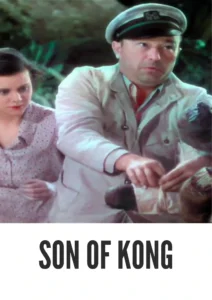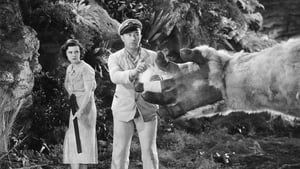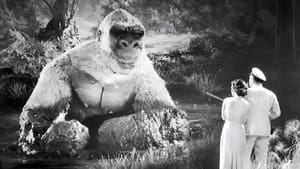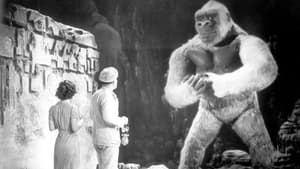Video Sources 0 Views
- Watch trailer
- The Son of Kong 1933 Colorized


Synopsis
Table of Contents
ToggleSkull Island Beckons: The Son of Kong (1933) in Dazzling Color

Venture into the world of Skull Island with The Son of Kong, a captivating adventure fantasy from 1933, now beautifully colorized for a viewing experience like never before. This film delivers a thrilling blend of adventure, humor, and heartwarming moments. Perfect for classic film enthusiasts, this HD download brings a charming piece of cinematic history to your screen.
The Son of Kong Storyline: A Return to Skull Island
The Son of Kong picks up shortly after the events of King Kong. Carl Denham, plagued by legal troubles and public resentment, decides to leave New York and sets sail once again. Along the way, he encounters Captain Englehorn, and they reluctantly agree to return to Skull Island in search of treasure.Upon reaching the island, they soon discover that it holds more than just memories of Kong. They encounter a smaller, albino ape – Kong’s son, affectionately nicknamed “Little Kong” or “Kiko.” Unlike his fearsome father, Kiko is friendly and helps Denham and his companions survive the dangers of the island, including quicksand, giant bears, and other prehistoric creatures. As they navigate the perilous landscape, Denham develops a bond with Kiko, leading to a series of humorous and heartwarming adventures. The film culminates in a dramatic earthquake that threatens to sink the island, with Kiko making a heroic sacrifice to save Denham. Ultimately, The Son of Kong is a delightful and entertaining sequel that offers a lighter, more whimsical take on the Kong legend.
Movie Cast
The film features a talented cast of actors who bring this adventurous story to life:
- Robert Armstrong as Carl Denham
- Helen Mack as Hilda Petersen
- Frank Reicher as Captain Englehorn
- John Marston as Helstrom
- Victor Wong as Charlie
Movie Genre
The Son of Kong falls into the genre of adventure fantasy, with elements of humor and heartwarming moments that distinguish it from its darker predecessor. Its fantastical setting and engaging plot make it a captivating and enjoyable film.
Historical Context: Following a Legend
Released in 1933, just months after the groundbreaking King Kong, The Son of Kong was created to capitalize on the original film’s immense success. While it may not have reached the same critical acclaim, it offers a fascinating glimpse into the filmmaking practices of the era and the studio’s attempt to expand the Kong universe. The film was produced during a time when special effects were still in their early stages, and The Son of Kong showcases some innovative techniques for creating its fantastical creatures and environments.
Colorization Details
This colorized version of The Son of Kong has been meticulously restored using modern digital techniques, enhancing the visual appeal while preserving the film’s original charm. The colorization process involved carefully analyzing the grayscale tones of the original black and white footage and assigning appropriate colors to each scene. While the specific software used remains proprietary, the techniques employed included advanced algorithms for color palette selection and image enhancement. This painstaking process brings new life to the characters and settings, making the story even more engaging for modern audiences. While some may debate the merits of colorizing classic films, it introduces these films to a broader audience, ensuring their legacy for future generations.
Technical Details
- Director: Ernest B. Schoedsack
- Screenplay: Ruth Rose
- Story by: Ruth Rose
- Cinematography: J.O. Taylor, Vernon L. Walker
- Edited by: Ted Cheesman
- Production Company: RKO Radio Pictures
- Distributed by: RKO Radio Pictures
- Runtime: 69 minutes
Technical Specifications
- Download Format: MP4
- Resolution: HD (1080p)
- Compatibility: Compatible with most devices, including smartphones, tablets, computers, and smart TVs.
Reviews and Critical Reception
The Son of Kong (1933) is often seen as a lighter, more whimsical sequel to the groundbreaking King Kong. While it may not have reached the same critical acclaim, it remains a fascinating and entertaining example of early adventure cinema and a valuable piece for Kong enthusiasts. As a relatively obscure but intriguing film, The Son of Kong provides a unique perspective on the early years of monster movies.
FAQs
- Q: What is The Son of Kong about?
- A: The Son of Kong is an adventure fantasy about Carl Denham’s return to Skull Island and his encounter with Kong’s friendly son.
- Q: Is The Son of Kong (1933) a well-known Kong film?
- A: While not as famous as King Kong, The Son of Kong is a notable sequel that offers a lighter take on the Kong legend.
- Q: Is this version of The Son of Kong colorized?
- A: Yes, this version has been professionally colorized to enhance the viewing experience.
- Q: What makes The Son of Kong interesting for Kong fans?
- A: The Son of Kong offers a unique and lighter perspective on the Kong universe, showcasing new creatures and characters.
- Q: What is the download format?
- A: The download format is MP4, which is compatible with most devices.
- Q: What resolution is the download?
- A: The resolution is HD (1080p), providing a high-quality viewing experience.
Download Now in HD!
Watch The Son of Kong Today!













